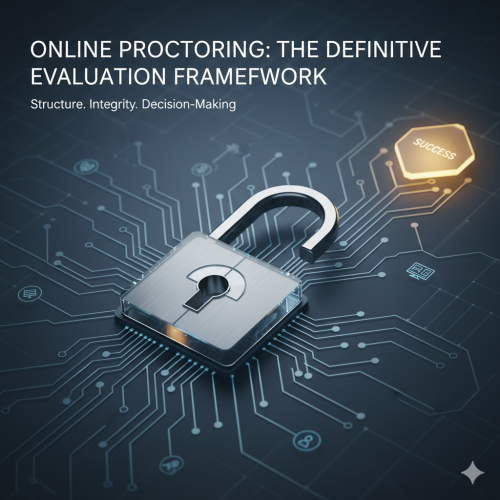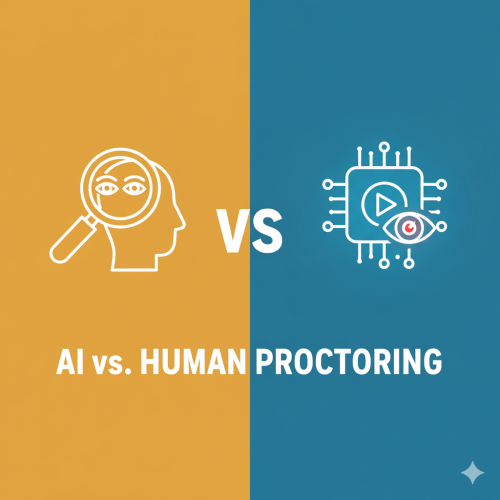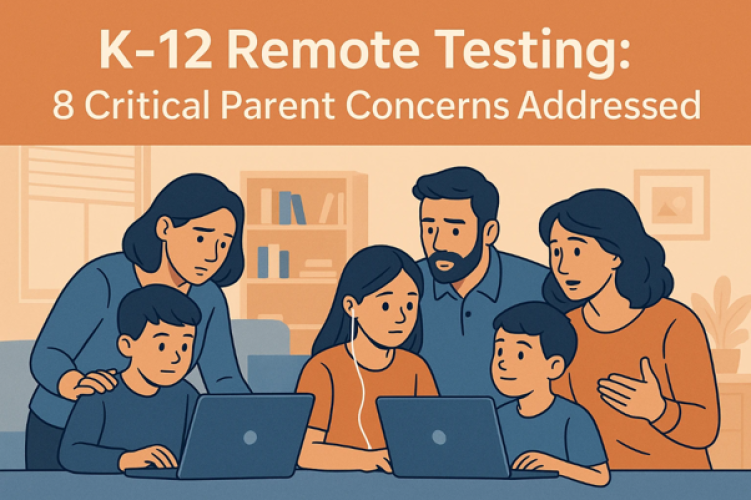Are you an EdTech company or an assessment provider looking to make online exams more secure? In today's digital world, preventing cheating and identity fraud in virtual tests is a huge challenge. Many institutions are now turning to biometric authentication in exams.
Biometrics offers a powerful solution. It uses unique physical or behavioral traits, like your face or fingerprints, to confirm who a test-taker is. This helps ensure that the right person is taking the exam and that results are fair and trustworthy.
However, this advanced technology comes with its own set of concerns. While it promises security, it also raises important questions about privacy. Collecting sensitive biometric data means taking on significant responsibilities.
For businesses in the online assessment space, understanding these privacy concerns isn't just good practice. It's essential for maintaining trust, avoiding legal issues, and protecting your reputation. Let's explore six critical privacy concerns related to biometric authentication in exams and how to navigate them effectively.
Understanding the Landscape: Biometrics in Online Assessments
What exactly is biometric exam authentication? Simply put, it's a method to verify a person's identity using their unique biological characteristics. This can include facial recognition, fingerprint scans, voice recognition, or even how someone types (keystroke dynamics).
In online exams, this technology typically works at the start of a test. It confirms the student's identity against their registered profile. During the exam, some systems might continuously monitor for changes in identity or suspicious behavior.
The main goal is to uphold exam integrity. It helps stop impersonation, where someone else takes the test. It also adds a layer of assurance that traditional methods can't always provide.
While the benefits in stopping fraud are clear, the sensitive nature of biometric data means privacy can't be an afterthought. You must balance the need for strong security with protecting individual data rights.
The 6 Critical Privacy Concerns of Biometric Authentication in Exams
A. Data Collection & Scope: Minimizing the Footprint
One major concern is collecting too much data. Some systems might gather raw images, extensive video, or detailed behavioral patterns that aren't strictly necessary for authentication. This "over-collection" increases your risk if that data ever falls into the wrong hands.
Every piece of data collected expands the potential impact of a breach. It also places a greater burden on you to protect it. Imagine a breach where not just a fingerprint, but full facial video records, are stolen. The long-term risks for individuals could be significant, right?
To address this, you'll want to adopt a "data minimization" principle. Only collect the absolute minimum data needed for authentication. For instance, instead of storing raw facial images, convert them into anonymized mathematical "templates." These templates can't be reverse engineered back to the original image.
Clearly define what data you collect and why. Communicate this transparently to test-takers. This approach reduces your risk surface and shows respect for privacy, making your system more secure and trustworthy.
B. Secure Storage & Retention: Protecting Irreplaceable Biometric Exam Authentication Data
Biometric data is unique and permanent. Unlike a password, you can't change your face or fingerprints if they're compromised. This makes secure storage critically important. Insecure storage, like unencrypted databases or weak access controls, is a huge risk.
A data breach involving biometric information can lead to permanent identity theft. It can expose individuals to fraud for the rest of their lives. Many people worry about how their sensitive data is stored and protected, which fuels skepticism about these systems.
Implementing robust security measures is non-negotiable. Use strong encryption for data both when it's stored (at rest) and when it's being moved (in transit). Employ strict access controls so only authorized personnel can reach the data, and you should track who accesses it.
Also, define clear and limited data retention periods. Only keep biometric data for as long as it's absolutely necessary for its intended purpose. Once it's no longer needed, securely
delete it. Consider advanced options like homomorphic encryption or decentralized storage models for added security.
C. Informed Consent & Transparency: Building Trust, Not Coercion
Privacy concerns often arise from a lack of clarity. If privacy policies are vague or full of legal jargon, test-takers might not truly understand what they're agreeing to. This can lead to "take-it-or-leave-it" consent, where students feel forced to agree to use the system.
Such situations erode trust and can lead to legal challenges. If students, parents, or privacy advocates feel their data rights are being ignored, it damages your reputation. Especially for minors, obtaining truly informed consent requires extra care and clear communication.
To build trust, your privacy policies must be clear, concise, and easy to understand. Avoid technical terms where possible. Explain exactly what data is collected, how it'll be used, stored, and for how long. Emphasize that consent should be explicit and opt-in.
Offer accessible explanations and frequently asked questions. Use a consent management platform that allows individuals to easily understand and manage their preferences. This proactive transparency helps build confidence and shows your commitment to ethical data handling.
D. Regulatory Compliance: Navigating a Global Patchwork
The world's got a complex web of data protection laws. Major regulations include GDPR in Europe, CCPA in California, and FERPA for student records in the US. In India, the Digital Personal Data Protection Act (DPDP Act 2023) adds new layers of compliance. Ignoring these laws can lead to hefty fines, legal action, and severe reputational damage.
Operating across different regions means you've got to understand various regulations. For instance, data transfer rules vary significantly. Failing to comply can restrict your operations and alienate your users, who expect their data rights to be respected.
Regular legal audits are crucial to ensure your systems meet all relevant requirements. Develop a robust compliance framework that can adapt to new laws. Pay close attention to cross-border data transfer rules, especially if your test-takers are in different countries.
Train your staff thoroughly on these regulations. This ensures everyone understands their role in protecting data. Staying ahead of regulatory changes, you'll avoid penalties and demonstrate your commitment to legal and ethical standards.
E. Algorithmic Bias & Fairness: Ensuring Equitable Access
Many biometric systems, especially facial recognition, use algorithms that can have biases. These biases sometimes lead to lower accuracy rates for certain demographic groups. For example, some systems might struggle more with darker skin tones or with women, leading to misidentification or denial of access.
This can have a disproportionate impact on test-takers. It can cause frustration, delays, or even accusations of discrimination. In high-stakes environments like exams, such issues can severely undermine the fairness and credibility of the entire assessment process. It raises concerns about civil liberties and equitable treatment.
Prioritize vendors who can demonstrate that their algorithms have been independently verified for fairness and accuracy across diverse demographics. Ask for evidence of bias testing and mitigation strategies. Look for certifications or reports from reputable organizations like NIST.
Be prepared to offer alternative authentication methods for those who might be unfairly impacted by biometric systems. Regular internal testing for bias is also a good practice. This ensures your system serves all test-takers fairly and without discrimination.
F. Third-Party Risks & Data Sharing: Understanding the Ecosystem
It's rare for an EdTech company to build all its technology from scratch. You likely work with third-party vendors for biometric solutions, proctoring, or data storage. Sharing biometric data with these partners without proper safeguards is a significant risk. You might lose control over how your data is handled.
If a third-party vendor experiences a data breach, your test-takers' information could be compromised. This extends your risk surface significantly. A vendor's privacy misstep can still reflect poorly on you, leading to reputational damage and liability.
Thoroughly vet all third-party vendors. Examine their privacy and security practices in detail. Ask about their data encryption, access controls, breach response plans, and compliance certifications. Ensure they adhere to the same high standards you uphold.
Establish strict data processing agreements (DPAs) with all vendors. These agreements should clearly outline how they can use, store, and protect the biometric data. And, you should clearly disclose any third-party data sharing in your privacy policies. This transparency is key to managing risks and maintaining trust.
IV. Best Practices for Implementing Privacy-First Biometric Exam Authentication
Implementing biometrics safely requires a proactive approach. Here are some best practices to consider for your EdTech or assessment platform:
Adopt a Privacy-by-Design Approach: Integrate privacy considerations from the very start of your system development. Don't just add privacy as an afterthought; this means designing systems that collect minimal data and have strong security built-in.
Prioritize Advanced Liveness Detection: Use technologies that can verify a person is physically present and not using a photo or video. This prevents spoofing while being transparent about how it works, minimizing intrusive data capture.
Offer Secure Multi-Factor Authentication (MFA): Combine biometrics with other factors like a secure password or a one-time passcode. This creates layers of security, making it much harder for unauthorized individuals to gain access.
Conduct Regular Privacy Impact Assessments (PIAs): Periodically assess how your biometric system affects privacy. Identify and mitigate risks before they become problems. This helps ensure ongoing compliance and data protection.
Provide Robust Training and Clear Communication: Educate your staff on data privacy best practices and regulatory requirements. Clearly communicate your policies to test-takers in simple language. Explain the benefits and safeguards in place.
Choose a Reputable and Compliant Biometric Partner: Select vendors known for their strong privacy frameworks, security certifications, and commitment to ethical AI. A good partner understands diverse regulatory landscapes and offers robust support.
V. The Future of Secure & Private Online Assessment
The online assessment landscape's always evolving. New technologies like decentralized identity aim to give individuals more control over their personal data. Homomorphic encryption allows data to be processed while remaining encrypted, offering incredible privacy benefits.
The key for you, as an EdTech company, is to balance innovation with ethical responsibility. Adopting cutting-edge solutions shouldn't ever come at the expense of user privacy. Instead,
technology should enhance both security and privacy.
By prioritizing privacy, online assessment companies can build systems that aren't just secure, but also trusted by students, parents, and regulators. This approach fosters a better learning and assessment experience for everyone. It sets a new standard for exam integrity in the digital age.
VI. Conclusion: Leading the Way in Trustworthy Exam Authentication
Biometric authentication offers undeniable advantages for securing online exams. It's a powerful tool against impersonation and cheating. However, ignoring the privacy concerns associated with it? That would be a critical mistake.
By proactively addressing issues like data collection, storage, consent, regulatory compliance, bias, and third-party risks, you can build truly trustworthy systems. This approach protects individuals and strengthens the credibility of online assessments.
Investing in privacy-first biometric solutions is an investment in your reputation. It builds user trust and ensures long-term success in the dynamic world of digital education. Be a leader in secure and privacy-compliant exam authentication. It's not just about technology; it's about trust.
Frequently Asked Questions about Biometric Authentication in Exams
1. How can we ensure our biometric exam authentication system is compliant with diverse global privacy regulations like GDPR, CCPA, and FERPA, especially when students are located in different countries?
Navigating global privacy regulations requires a comprehensive strategy. Start by conducting a thorough legal review to identify all applicable laws based on your operational regions and where your students reside. Develop an internal compliance framework that harmonizes these requirements, aiming for the highest common denominator of protection.
Implement strong data governance policies, including explicit consent mechanisms tailored to each regulation's specifics. Ensure your data processing agreements with vendors are compliant. You'll want to regularly update your policies and train staff to stay current with evolving laws like India's DPDP Act or EU's GDPR.
2. Students are concerned about their biometric data being stored indefinitely or misused. How do we transparently communicate our data collection, storage, and retention policies to build trust and get informed consent without legal repercussions?
Transparency is key to building trust. Create clear, concise, and jargon-free privacy policies that explain exactly what biometric data is collected, why it's needed, how it's used, and how it's securely stored. Crucially, specify strict data retention periods, explaining when and how data will be securely deleted.
Obtain explicit, opt-in consent from all test-takers, especially for minors, requiring parental or guardian approval. Provide easy-to-understand FAQs and possibly short explainer videos. Make sure students feel they have control over their data and can withdraw consent if needed, understanding the implications.
3. Are there specific biometric modalities (e.g., facial recognition, keystroke dynamics) that are less intrusive or carry fewer privacy risks for exam authentication, and how do we choose the most appropriate one for our context?
Different biometric modalities do carry varying levels of privacy risk and intrusiveness. Keystroke dynamics, which analyzes typing patterns, is often seen as less intrusive than facial recognition, as it doesn't capture a direct image of the person. Voice recognition also has its own set of privacy implications.
The choice depends on your specific needs, the level of assurance required, and your target audience's comfort level. Consider the sensitivity of the data collected by each method and the security measures applied. Prioritize solutions that rely on anonymized templates rather than raw data, regardless of the modality.
4. What happens if a student's biometric data is compromised in a breach? Since it's permanent, what are the long-term implications for the student and our institution, and how can we mitigate this severe risk?
A breach of biometric data is severe because it's permanent and can't be changed. For the student, it could lead to lifelong identity theft and fraud risks. For your institution, it means significant reputational damage, loss of trust, substantial fines, and potential legal action from affected individuals.
Mitigation starts with prevention: employ robust encryption, strict access controls, and regular security audits. In case of a breach, have a clear incident response plan. This plan should include immediate notification to affected individuals and relevant authorities, offering credit monitoring services, and transparent communication about steps taken to contain the breach.
5. Our concern is that biometric systems might unfairly disadvantage or misidentify certain student demographics, leading to accusations of bias. How do we ensure fairness and avoid algorithmic discrimination in our exam authentication process?
Algorithmic bias is a valid concern, particularly in facial recognition systems that might perform less accurately across different skin tones or genders. To ensure fairness, demand independent third-party evaluations of any biometric system you consider. Look for reports that detail accuracy rates across diverse demographic groups.
Partner with vendors committed to ethical AI development and continuous bias testing. Implement your own internal audits to detect and address any emerging biases. Most importantly, always provide clear, non-biometric alternative authentication methods for students who may be affected by bias or prefer not to use biometrics.















